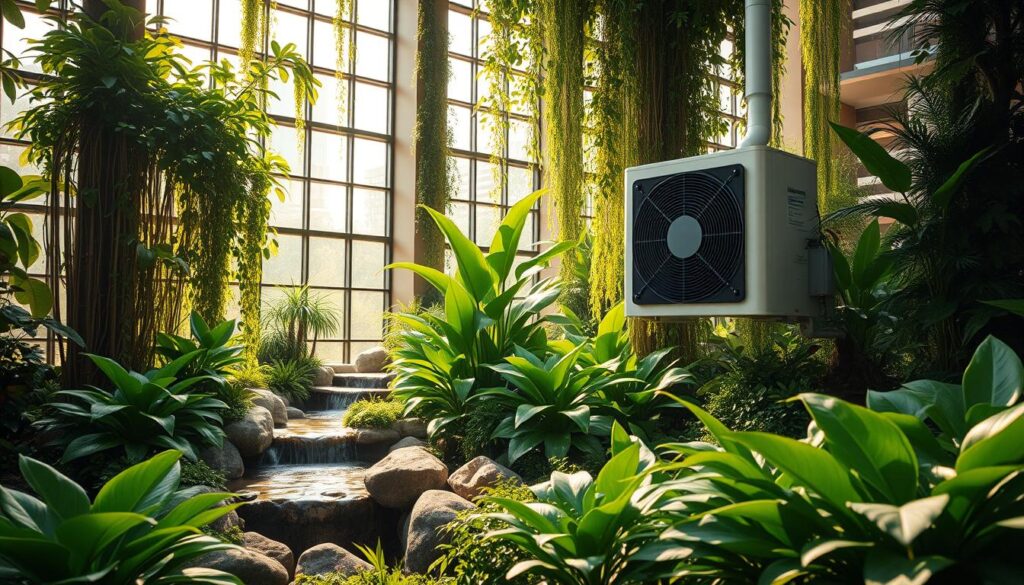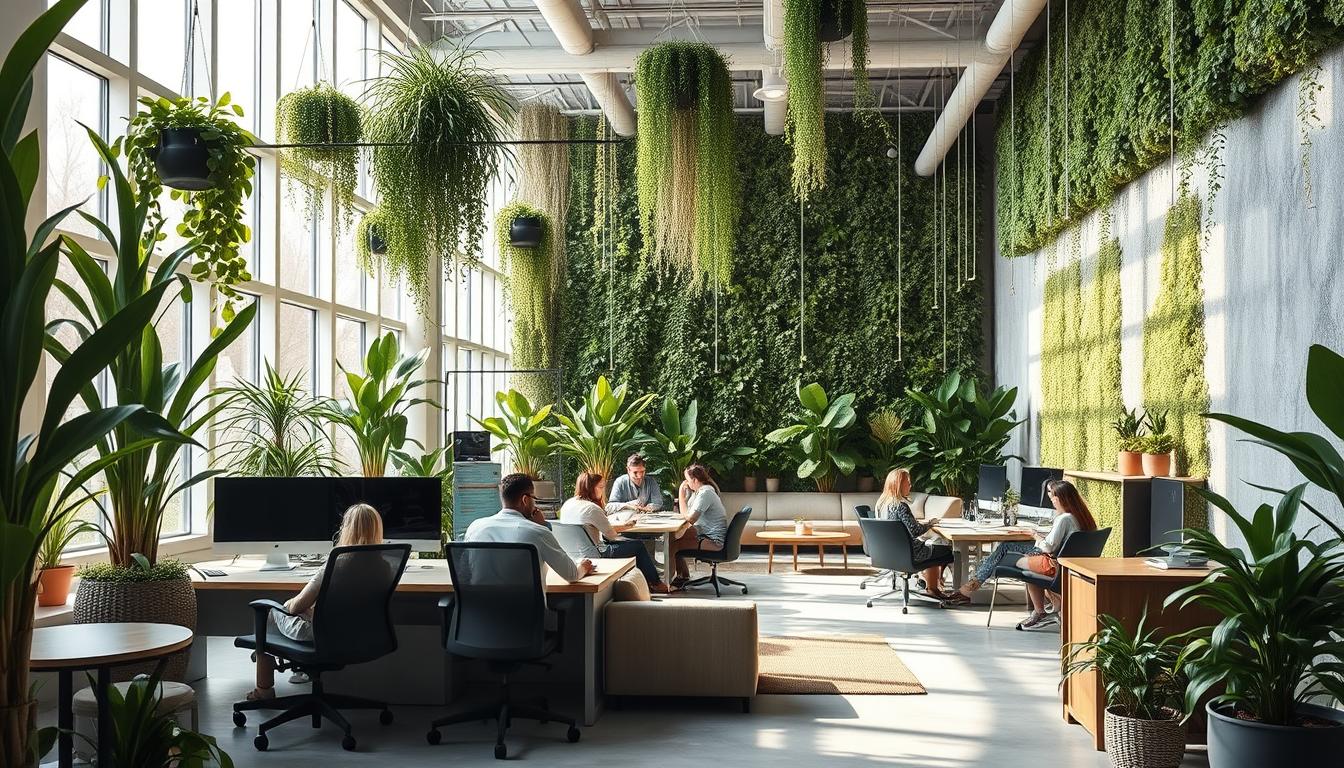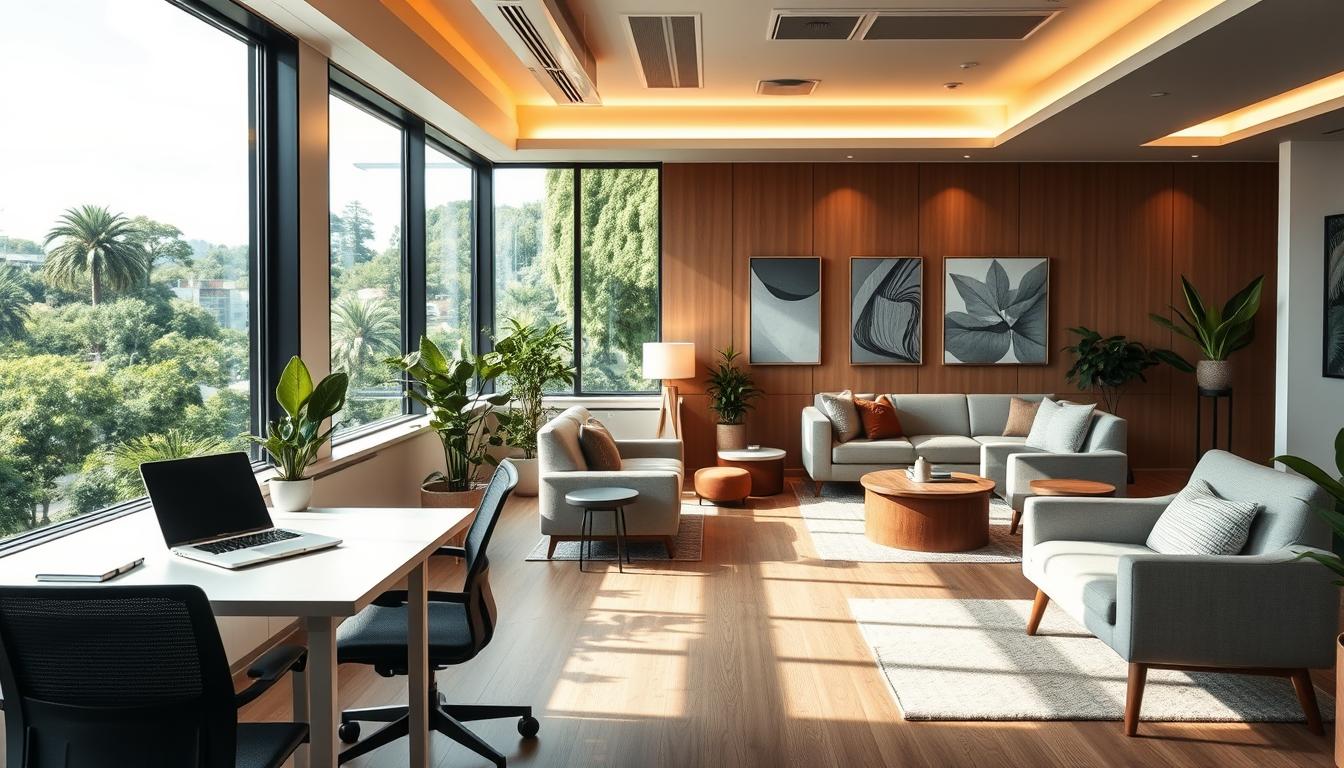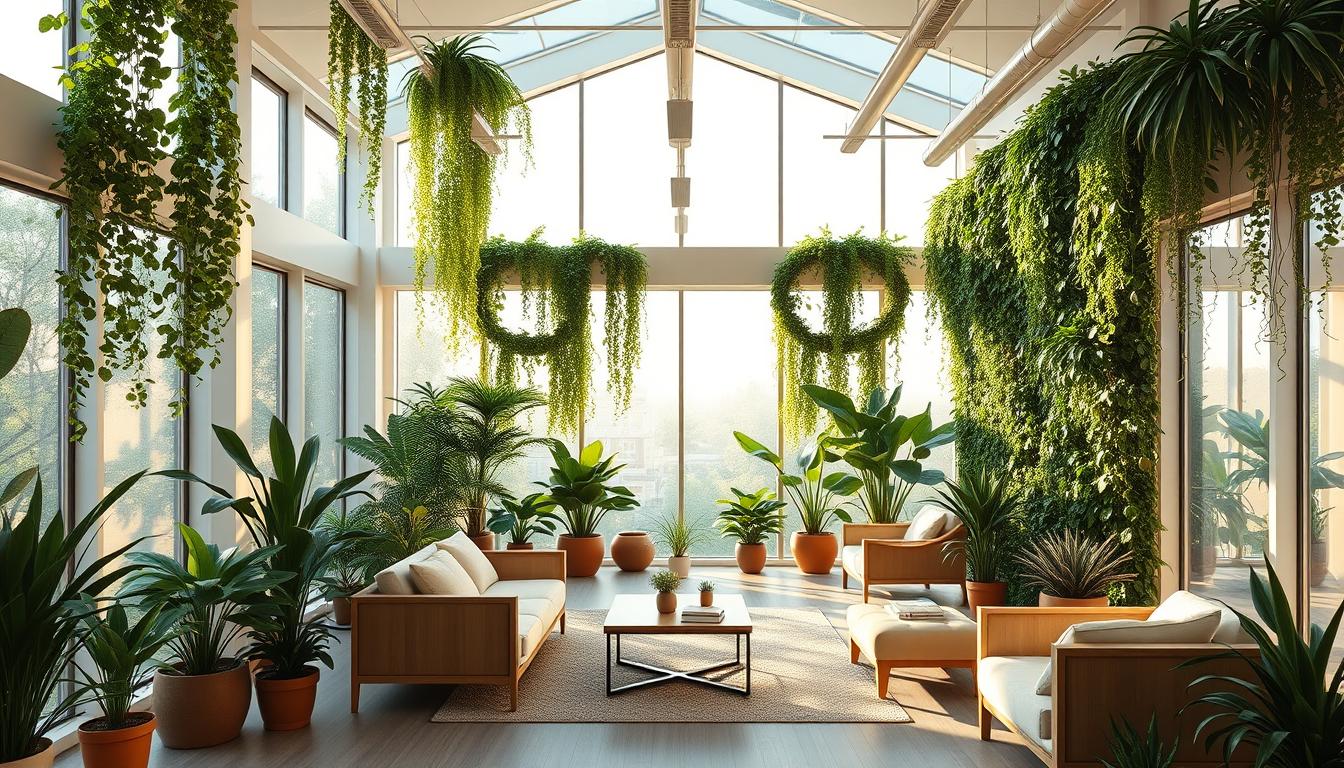More people are choosing sustainability these days. Biophilic cooling systems stand out as an eco-friendly choice for air conditioning. They merge indoor spaces with nature and cut down energy use.
Using new tech and materials, these ACs provide comfort and are better for the planet. This article dives into biophilic cooling systems, their benefits, and how they’re changing AC for the better.
Understanding Biophilic Cooling Systems
Biophilic cooling systems are a new way to make indoor spaces comfortable while caring for the planet. These systems use the idea of biophilic design. This concept is about linking people and nature closely. By bringing nature into HVAC design, these systems help people feel better and more comfortable.
The main parts of cooling systems are natural air flow, passive cooling, and eco-friendly materials. Natural ventilation brings in fresh air and cuts down on the need for artificial cooling. Passive cooling uses things like shade and breezes to keep temperatures down without using a lot of energy.
Using biophilic systems makes spaces more comfortable and really helps the environment. These systems use less energy and reduce harmful emissions. It’s important to know how biophilic cooling works. This knowledge can help use them effectively in homes and businesses.

The Benefits of Eco-Friendly Air Conditioning
Eco-friendly air conditioning systems offer big perks for both the planet and our wallets. They use less energy, which means we pay less in energy bills. These systems also use the latest tech to keep rooms cool efficiently.
These systems are great for making indoor air cleaner and healthier. This means we feel more comfortable and healthier at home. They also have a smaller impact on our planet than old AC units. This makes them a smart choice for those who care about the Earth.
With stricter rules on air pollution, eco-friendly ACs are becoming a must-have. They perform well and help us follow new environmental laws. Plus, they support a greener lifestyle.
Sustainable Materials in Cooling System Design
Using sustainable materials in cooling system design makes buildings more eco-friendly. Materials like bamboo, recycled steel, and non-toxic finishes have many benefits. They lower the environmental harm from their production and are also durable.
Picking these materials helps reduce carbon emissions during transport and making. This choice means cooling systems last longer, which cuts down on the need for replacements. Also, sustainable materials help create healthier indoor spaces, which is good for everyone inside.
Energy Efficiency and Cost Savings with Biophilic Systems
Biophilic cooling systems are great at making places use less energy and saving money. They use the latest in HVAC tech. This tech adjusts to how many people are there and the time of day. Because of this, they use less energy, which is good for our planet.
These smart systems help cut down on how much energy people use. They also save money in the long run. Features like smart thermostats make it easier to control temperature. They also help keep an eye on energy use. All of this helps the environment and saves money too.
Incorporating Passive Cooling Techniques
Passive cooling techniques are key in designing eco-friendly cooling systems. They use natural ways to control temperature and cut down on energy use. One main method is to use windows that help create natural air flows. This cools the indoor air without using much energy.
Shading devices also play a big role in keeping buildings cool. Items like awnings block the sun and keep indoors cooler. Adding materials that store heat during the day and release it at night helps too. This balances the indoor temperature naturally.
By using these techniques, companies rely less on artificial cooling. This also makes the air inside better to breathe. Buildings that balance being comfortable and green show why it’s good to use these cooling methods.
Properties of Low-GWP Refrigerants
Refrigerants with a Low Global Warming Potential (GWP) are key in creating eco-friendly cooling systems. These include HFCs, HFOs, and various blends. They boost energy efficiency and help meet environmental rules.
Choosing low-GWP refrigerants brings several benefits:
- Enhanced Energy Efficiency: These refrigerants often provide superior cooling capabilities, leading to lower energy consumption.
- Environmental Safety: They help reduce greenhouse gas emissions, supporting global efforts to combat climate change.
- Regulatory Compliance: Utilization of low-GWP refrigerants aligns with the evolving regulations aimed at promoting environmentally-friendly refrigerants.
Natural refrigerants like ammonia and CO2, however, face challenges like being less efficient and harder to manage. Yet, low-GWP alternatives offer a good mix of efficiency and eco-friendliness. They are becoming the go-to choice for new air conditioning systems.
Biophilic Cooling Systems: Enhancing Indoor Environments
Biophilic cooling systems greatly improve our indoor spaces by bringing nature inside. They use smart tech to clean the air we breathe. By taking away harmful pollutants and allergens, they make our living areas healthier.
When buildings include nature in their design, they look better and make us feel better too. Things like gardens inside and walls full of plants do more than just decorate. They help us relax, cut down on stress, and work better.
By mixing nature with new air-cleaning tech, these systems turn our indoor areas into cozy, healthy spots. Making health and comfort key parts of our spaces helps us live better. It also builds a stronger bond with nature around us.
Natural Ventilation Strategies for Improved Air Quality
Natural air flow is key to better air inside buildings. By using methods like cross-ventilation, buildings let in fresh air. This reduces the need for electric air conditioners, making it greener and saving energy.
Good natural airflow systems help in many ways. They can:
- Decrease indoor pollutants, thus enhancing air quality.
- Improve comfort levels by ensuring a consistent flow of fresh air.
- Support energy efficiency by reducing reliance on traditional cooling methods.
Setting up these systems takes careful planning and understanding how air moves. When designed well, openings line up with the wind. This boosts natural air flow. It’s a major part in better air quality and a healthier indoor environment.
Regular Maintenance for Optimal Performance
Regular check-ups keep HVAC systems working well and lasting longer. Doing this helps avoid big problems like leaks. Leaks can cause more greenhouse gases, which is bad for our planet.
Facility managers should have a detailed maintenance plan. This plan should include:
- Routine inspections to spot and fix any issues early.
- Frequent filter replacements to keep air flowing and use less energy.
- Detailed checks on refrigerant levels to avoid leaks.
- Cleaning parts to make sure heating and cooling is efficient.
Staying on top of maintenance helps track energy use better. It leads to quick changes that make systems work better. Efficient systems cut down costs and are better for the earth. So, proper care is key for meeting financial and eco-friendly aims.
Smart Thermostats: Maximizing Energy Efficiency
Smart thermostats are key in biophilic cooling systems for better energy use. They adjust to how often people are around, controlling temperatures accurately. This means they can change settings when no one is there, cutting down on unnecessary energy use.
These thermostats make life easier too. You can change your place’s climate from your phone. This lets you make changes anytime, helping you save energy all the time.
Putting smart thermostats in cooling systems is vital for eco-friendly living or working spaces. They mix technology with caring for the environment. This helps lower energy bills and saves our natural resources too.
Creating Green Spaces for Comfort and Functionality
Green spaces make urban areas more comfortable. They use biophilic design to link us with nature. This link offers psychological pluses. Plants and trees make spaces look good and help our mental health.
Green spaces have many roles, like:
- Regulating temperature: Vegetation aids in cooling areas naturally.
- Reducing air pollution: Plants filter harmful pollutants, contributing to healthier air quality.
- Enhancing aesthetic appeal: Greenery adds visual interest and promotes a welcoming atmosphere.
Using these design ideas makes indoor and outdoor places peaceful and useful. People enjoy comfort and touch with nature here.
Legislation and Regulations Impacting Cooling Systems
The air conditioning world follows strict rules to protect our planet. Laws like the F-gas regulations and parts of the Net-Zero Industry Act push companies to improve how they cool things down. They’re moving towards eco-friendly cooling methods that are good for the Earth and save energy.
Companies need to keep up with these rules to stay compliant. They must think about:
- Using coolants that don’t harm the atmosphere as much.
- Putting in systems that use less energy to meet legal standards.
- Checking their cooling setups regularly to make sure they’re eco-friendly.
This commitment helps the industry do its part for the environment and work better.
Conclusion
Biophilic cooling systems mark a big step towards greener air conditioning. They focus on eco-friendly ways that include nature, tackling energy use and environmental harm.
These systems use less energy, green materials, and new air flow ideas. This improves indoor comfort and lessens the bad impacts of usual cooling methods. The move towards being more eco-conscious worldwide makes adopting biophilic cooling vital for healthier living spaces.
Embracing these green practices improves our living experiences and helps our planet. The future of keeping our spaces cool lies in balancing comfort with caring for the environment. Biophilic cooling systems show great promise in achieving this balance.



